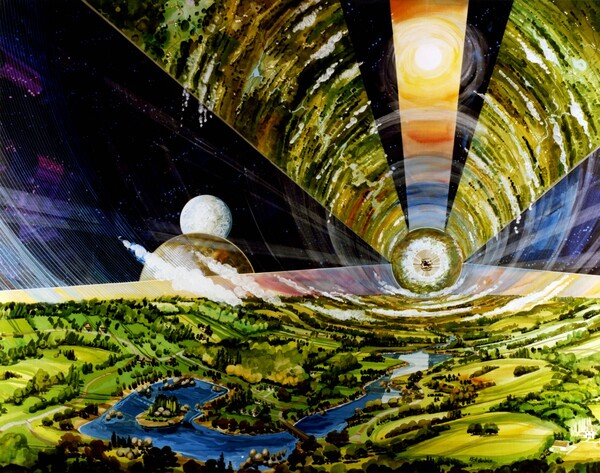This article asks: O’Neill Cylinders and the future of human evolution: How living in space could change our biology. Find out more about How Living In O’Neill Cylinders Could Change Our Biology.

As humanity begins to explore the possibilities of space colonization, questions arise about how living in space could affect our biology over time.
One potential avenue for space settlement is the O’Neill Cylinder, a hypothetical space habitat designed to simulate Earth-like living conditions through the use of rotating cylinders. In this article, we will explore the potential impact of O’Neill Cylinders on the future of human evolution.
From the physical adaptations that may arise from living in a low-gravity environment to the cultural and technological changes that could shape our relationship to our environment, we will examine the ways in which life in space could alter the course of human evolution in ways that we cannot yet predict.
As we prepare for a future in which humanity may become a space-faring species, it is important to consider the potential consequences of living in space and how they may shape the future of our species.
How Will Life In O’Neill Cylinders Effect Human Evolution?
Living in O’Neill Cylinders could potentially have an effect on human evolution, although the extent of this effect is difficult to predict.
Here are some potential ways that living in O’Neill Cylinders could impact biology and human evolution:
Adaptation to low gravity:
O’Neill Cylinders would be designed to simulate Earth-like gravity through the use of rotating habitats, but the gravity within the habitats would still be lower than Earth’s gravity. Living in a low-gravity environment could potentially lead to the evolution of physical adaptations that are better suited to life in space, such as changes in bone density or muscle mass.
Genetic changes:
Exposure to radiation and other environmental factors in space could potentially lead to genetic changes that impact human evolution over time. O’Neill Cylinders would be shielded from much of the harmful radiation present in space, but there may still be some exposure to cosmic rays and other forms of radiation.
Cultural changes:
Living in a self-contained environment like an O’Neill Cylinder could lead to the development of new cultural norms and practices that influence human evolution. For example, the limited living space within the habitats may lead to a greater emphasis on communal living and social cooperation.
Technological advancements:
The development of new technologies and techniques for living in space could potentially influence human evolution by altering our relationship to our environment and changing the way we interact with it. For example, the development of advanced recycling technologies could reduce our dependence on Earth’s resources and change the way we think about sustainability.
It is worth noting that any significant evolutionary changes are likely to take place over a much longer time frame than the lifespan of an individual, and may require many generations to become evident.
Nonetheless, it is possible that living in O’Neill Cylinders could have an impact on biology and human evolution in ways that we cannot yet predict.
What Would Life Be Like In An O’Neill Cylinder?
Life in an O’Neill Cylinder would be vastly different from life on Earth, but it would still offer many of the amenities and comforts that we are accustomed to.
Life in an O’Neill Cylinder would require significant adaptation and adjustment, but it would still offer many of the comforts and amenities that we are accustomed to on Earth.
The ability to sustain human life in space would open up new opportunities for exploration and discovery, as well as the potential for long-term human settlement beyond Earth.
Here are some key aspects of life in an O’Neill Cylinder:
Gravity:
The artificial gravity created by the rotation of the cylinder would be similar to Earth’s gravity, allowing people to move and work without the physical challenges of zero gravity.
Living quarters:
Living quarters in an O’Neill Cylinder would likely be similar to apartments or condominiums on Earth, with separate living spaces, bedrooms, and bathrooms.
Agriculture:
Agriculture would be a vital component of life in an O’Neill Cylinder, as food would need to be grown in order to sustain the inhabitants. Vertical farming techniques and hydroponics systems would likely be used to maximize space and efficiency.
Recreation:
An O’Neill Cylinder would likely have recreational areas such as parks, sports fields, and theaters, as well as virtual reality and gaming facilities.
Education and work:
Education and work would still be important aspects of life in an O’Neill Cylinder, with schools, universities, and offices providing opportunities for learning and employment.
Health and wellness:
An O’Neill Cylinder would need to provide medical facilities and services to ensure the health and well-being of its inhabitants. Gyms and other fitness facilities would also be important to maintain physical health.
How Does Living In An O’Neill Cylinder Effect People?
Living in an O’Neill Cylinder would have a number of effects on people, both physical and psychological.
Here are some potential effects to consider:
Physical effects:
The artificial gravity created by the rotation of the cylinder would help to prevent the physical effects of long-term exposure to zero gravity, such as muscle atrophy and bone loss.
Living in a closed environment for an extended period of time could also have negative physical effects, such as reduced exposure to natural light and a potential lack of fresh produce in the diet.
Psychological effects:
Living in an O’Neill Cylinder would require a significant adjustment to a completely new environment, which could cause feelings of isolation and confinement.
Social spaces and recreational activities would be important for promoting social interaction and mental well-being. Additionally, the sense of purpose and accomplishment associated with the exploration and colonization of space could be a positive psychological effect.
Cultural effects:
Living in an O’Neill Cylinder would likely require the development of a new culture and way of life, which could be influenced by the diverse backgrounds and experiences of the inhabitants. Additionally, the self-contained nature of the habitat could promote a greater sense of interdependence and cooperation among the inhabitants.
Environmental effects:
An O’Neill Cylinder would need to be designed and operated with sustainability in mind, which could promote greater awareness and concern for the environment among the inhabitants.
The unique environmental conditions of space could lead to the development of new technologies and practices for managing resources and minimizing waste.
Overall, living in an O’Neill Cylinder would require significant adaptation and adjustment, but it could also offer unique opportunities for exploration, discovery, and the development of a new way of life beyond Earth.
Will Life In Space Effect Human Evolution?
It is possible that life in space could have an effect on human evolution, although the extent of this effect is difficult to predict. Here are some potential ways that living in space could impact human evolution:
Any significant evolutionary changes are likely to take place over a much longer time frame than the lifespan of an individual, and may require many generations to become evident.
Additionally, the genetic diversity of the human population would likely be reduced in a space habitat due to the limited number of individuals living in a confined environment. Nonetheless, it is possible that life in space could have an impact on human evolution in ways that we cannot yet predict.
Adaptation to low gravity:
Living in a low-gravity environment could potentially lead to the evolution of physical adaptations that are better suited to life in space, such as changes in bone density or muscle mass.
Genetic changes:
Exposure to radiation and other environmental factors in space could potentially lead to genetic changes that impact human evolution over time.
Cultural changes:
Living in a self-contained environment like an O’Neill Cylinder could lead to the development of new cultural norms and practices that influence human evolution.
Technological advancements:
The development of new technologies and techniques for living in space could potentially influence human evolution by altering our relationship to our environment and changing the way we interact with it.
References for: “O’Neill Cylinders and the future of human evolution: How living in space could change our biology”
O’Neill, G. K. (1976). The colonization of space. Physics Today, 29(9), 32-40.
Smith, C. (1982). Space colonies–A cooperative venture. Science, 218(4575), 1095-1101.
Spitzmiller, T. (2008). The Von Neumann, Bernal, and O’Neill Models of Space Colonization: A Comparative Analysis. Journal of the British Interplanetary Society, 61(11), 414-420.
Johnson, S. (2019). Living on the Moon: The Challenges, the Technology, and the People Behind It. Thames & Hudson.
Strickland, E. (2016). Space Tourism: Adventures in Earth Orbit and Beyond. Springer.
Wilson, J. W., Cucinotta, F. A., Shinn, J. L., Simonsen, L. C., & Dubey, R. R. (2003). Galactic cosmic radiation-induced ionizing radiation dose on extravehicular activity missions to the Moon. Advances in Space Research, 31(1), 65-72.
Sung, Y., Jurgens, R. F., & Putcha, L. (2012). Evolution of interplanetary human spaceflight: A case for a permanent lunar settlement. Acta Astronautica, 79, 94-100.
Smith, D. A. (2011). The physiological effects of microgravity and hypogravity on humans. Journal of the Royal Society of Medicine, 104(6), 241-247.
‘O’Neill Cylinders and the future of human evolution: How living in space could change our biology’ is one important topic in our series exploring the role of O’Neill Cylinders in space colonization.
Read more about these topics by following the links below:
Republished by Blog Post Promoter
